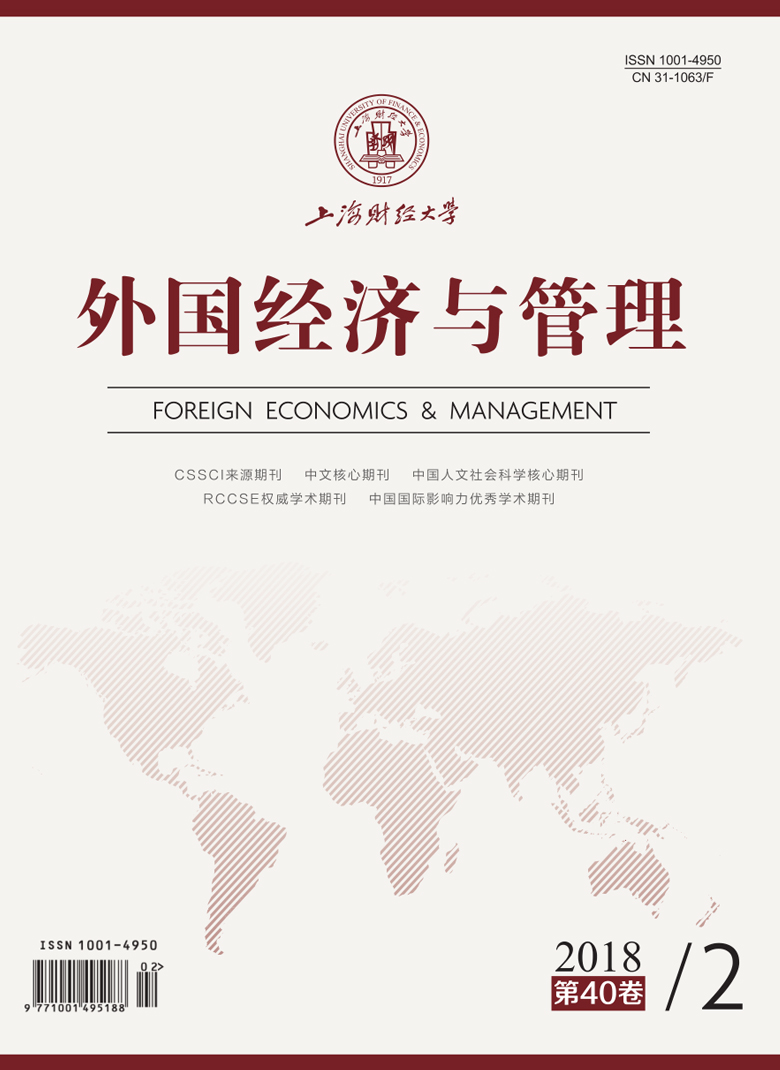新企业创立初期存活率低,深受“新进入缺陷”的困扰,成立条件对其生存具有“烙印”作用。本文选择2004—2011年的江苏省制造业企业数据,以资源禀赋和创新行为这两种成立条件为研究对象,考察两者对新企业生存的影响。研究发现:新企业的存活依赖于资源禀赋的丰富程度,采取创新行为能改善新企业的生存状态,两者存在相互替代的交互关系。同时,创新行为的作用具有异质性:辅助性工艺创新的作用优于生产性工艺创新,生产性工艺创新的作用优于工艺创新的整体效果,而产品创新的作用并不显著。本文从资源和战略的视角,验证了创立条件对新企业生存的“烙印”作用,从而深化了组织“烙印”作用理论在企业发展演化过程中的应用,并为解读中国情境下新企业生存问题提供了新的理论视角和经验证据。
资源依赖还是创新制胜?——基于组织“烙印”作用的新企业生存研究
摘要
参考文献
2 毕克新, 丁晓辉, 冯英浚. 制造业中小企业工艺创新能力测度指标体系的构建[J]. 数量经济技术经济研究, 2002, (12): 104–107. DOI:10.3969/j.issn.1000-3894.2002.12.026
11 花磊, 王文平. 不同创新类型下的有效创新网络结构[J]. 管理工程学报, 2014, (3): 110–119, 90.
25 徐虹, 林钟高, 芮晨. 产品市场竞争、资产专用性与上市公司横向并购[J]. 南开管理评论, 2015, (3): 48–59.
33 Andrews K R. The concept of corporate strategy[M]. Homewood, IL: Dow Jones Irwin, 1971.
34 Baker T, Nelson R E. Creating something from nothing: Resource construction through entrepreneurial bricolage[J]. Administrative Science Quarterly, 2005, 50(3): 329–366. DOI:10.2189/asqu.2005.50.3.329
35 Barney J. Firm resources and sustained competitive advantage[J]. Journal of Management, 1991, 17(1): 99–120. DOI:10.1177/014920639101700108
36 Becker G S. Human capital: A theoretical and empirical analysis, with special reference to education[M]. New York: University of Chicago Press, 2009.
37 Boeker W. Strategic change: The effects of founding and history[J]. Academy of Management Journal, 1989, 32(3): 489–515. DOI:10.2307/256432
38 Child J, Chung L, Davies H. The performance of cross-border units in China: A test of natural selection, strategic choice and contingency theories[J]. Journal of International Business Studies, 2003, 34(3): 242–254. DOI:10.1057/palgrave.jibs.8400033
39 Cooper A C, Gimeno-Gascon F J, Woo C Y. Initial human and financial capital as predictors of new venture performance[J]. Journal of Business Venturing, 1994, 9(5): 371–395. DOI:10.1016/0883-9026(94)90013-2
40 Delmar F, Shane S. Does experience matter? The effect of founding team experience on the survival and sales of newly founded ventures[J]. Strategic Organization, 2006, 4(3): 215–247. DOI:10.1177/1476127006066596
41 Dertouzos M L, Lester R K, Solow R M. Made in America[M]. Cambridge, MA: MIT Press, 1989.
42 Desa G, Basu S. Optimization or bricolage? Overcoming resource constraints in global social entrepreneurship[J]. Strategic Entrepreneurship Journal, 2013, 7(1): 26–49. DOI:10.1002/sej.2013.7.issue-1
43 Duymedjian R, Rüling C C. Towards a foundation of bricolage in organization and management theory[J]. Organization Studies, 2010, 31(2): 133–151. DOI:10.1177/0170840609347051
44 Eisenhardt K M, Schoonhoven C B. Organizational growth: Linking founding team, strategy, environment, and growth among U.S. Semiconductor ventures, 1978—1988[J]. Administrative Science Quarterly, 1990, 35(3): 504–529. DOI:10.2307/2393315
45 Fatoki O O. The impact of human, social and financial capital on the performance of small and medium-sized enterprises (SMEs) in South Africa[J]. Journal of Social Sciences, 2011, 29(3): 193–204. DOI:10.1080/09718923.2011.11892970
46 Fontana R, Nesta L. Product innovation and survival in a high-tech industry[J]. Review of Industrial Organization, 2009, 34(4): 287–306. DOI:10.1007/s11151-009-9210-7
47 Garud R, Karnøe P. Bricolage versus breakthrough: Distributed and embedded agency in technology entrepreneurship[J]. Research Policy, 2003, 32(2): 277–300. DOI:10.1016/S0048-7333(02)00100-2
48 Geroski P A, Mata J, Portugal P. Founding conditions and the survival of new firms[J]. Strategic Management Journal, 2010, 31(5): 510–529.
51 Johnson V. What is organizational imprinting? Cultural entrepreneurship in the founding of the Paris opera[J]. American Journal of Sociology, 2007, 113(1): 97–127. DOI:10.1086/517899
52 Judge W Q, Hu H W, Gabrielsson J, et al. Configurations of capacity for change in entrepreneurial threshold firms: Imprinting and strategic choice perspectives[J]. Journal of Management Studies, 2015, 52(4): 506–530. DOI:10.1111/joms.12121
53 Lévesque M, Shepherd D A. Entrepreneurs’ choice of entry strategy in emerging and developed markets[J]. Journal of Business Venturing, 2004, 19(1): 29–54. DOI:10.1016/S0883-9026(02)00111-8
54 Marquis C, Tilcsik A. Imprinting: toward a multilevel theory[J]. The Academy of Management Annals, 2013, 7(1): 195–245. DOI:10.1080/19416520.2013.766076
55 McDougall P P, Robinson Jr R B, DeNisi A S. Modeling new venture performance: An analysis of new venture strategy, industry structure, and venture origin[J]. Journal of Business Venturing, 1992, 7(4): 267–289. DOI:10.1016/0883-9026(92)90002-9
56 Penrose E T. The Theory of the growth of the firm[M]. New York: John Wiley, 1959.
58 Pieper T M, Smith A D, Kudlats J, et al. The persistence of multifamily firms: Founder imprinting, simple rules, and monitoring processes[J]. Entrepreneurship Theory and Practice, 2015, 39(6): 1313–1337. DOI:10.1111/etap.12179
59 Rouvinen P. Characteristics of product and process innovators: Some evidence from the Finnish innovation survey[J]. Applied Economics Letters, 2002, 9(9): 575–580. DOI:10.1080/13504850110108102
60 Schumpeter J A. The theory of economic development: An inquiry into profits, capital, credit, interest, and the business cycle[M]. Piscataway, NJ: Transaction Publishers, 1934.
61 Shinkle G A, Kriauciunas A P. The impact of current and founding institutions on strength of competitive aspirations in transition economies[J]. Strategic Management Journal, 2012, 33(4): 448–458. DOI:10.1002/smj.v33.4
62 Simsek Z, Fox B C, Heavey C. " What’s past is prologue”: A framework, review, and future directions for organizational research on imprinting[J]. Journal of Management, 2015, 41(1): 288–317. DOI:10.1177/0149206314553276
63 Singh J V, Lumsden C J. Theory and research in organizational ecology[J]. Annual Review of Sociology, 1990, 16: 161–195. DOI:10.1146/annurev.so.16.080190.001113
64 Stinchcombe A L. Social structure and organizations[A]. March J G. Handbook of Organizations[M]. Chicago: Rand McNally, 1965.
65 Utterback J M, Abernathy W J. A dynamic model of process and product innovation[J]. Omega, 1975, 3(6): 639–656. DOI:10.1016/0305-0483(75)90068-7
66 Van de Ven A H, Hudson R, Schroeder D M. Designing new business startups: Entrepreneurial, organizational, and ecological considerations[J]. Journal of Management, 1984, 10(1): 87–108. DOI:10.1177/014920638401000108
69 Zahra S A, Ireland R D, Hitt M A. International expansion by new venture firms: International diversity, mode of market entry, technological learning, and performance[J]. Academy of Management Journal, 2000, 43(5): 925–950. DOI:10.2307/1556420
引用本文
李贲, 吴利华. 资源依赖还是创新制胜?——基于组织“烙印”作用的新企业生存研究[J]. 外国经济与管理, 2018, 40(2): 35-50.
导出参考文献,格式为:
上一篇:顾客心理所有权研究综述与展望





 13225
13225  9604
9604

